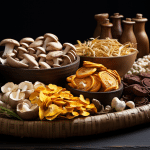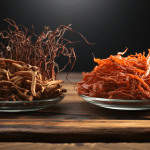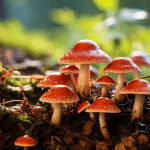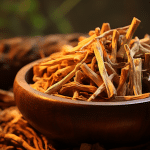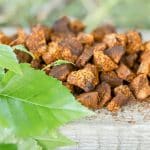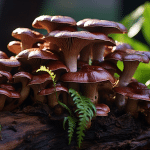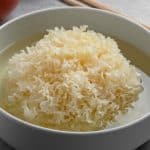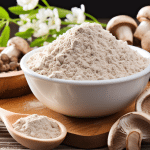Growing mushrooms is not difficult, but it does require some proper supplies in order to be successful. In this article, we are going to give you the mushroom growing supplies checklist. It will give you all the supplies that you will need to start growing your mushrooms.
Our Essential List of Mushroom Growing Supplies
- Mushroom spawn
- Substrate (the growing medium)
- Grow bags (or buckets)
- A thermometer
- A water spray bottle
Growing mushrooms can take a lot of supplies, or little, depending on how complex your growing operation is. What you will need may be very different depending on the number of mushrooms you wish to grow. Plus, what kind of mushrooms you are growing, and what methods you are going to be using.
For our easiest instructions on growing mushrooms, you can follow the step-by-step tutorial. All you will need is the list of supplies below.
Learn more: Mushroom nutrition information
1. Mushroom Spawn
Mushroom spawn is one of the most essential supplies that you need to get started growing mushrooms. To ensure you can grow mushrooms with a high harvest rate and good quality, it is essential that you purchase mushroom spawn from a reputable vendor. An established, commercial vendor will be able to supply you with contaminant-free spawn.
This means that you are starting out with the best possible odds for success. It is extremely rare to find a brick-and-mortar store selling spawned mushrooms in your town. So, you are more than likely going to need to order it online and get it shipped to you.
Mushroom starters are typically grown in either grains or wood chips. Sawdust spawn is generally cheaper, but we prefer wheat spawn because it tends to support stronger mycelium, and has more nutritional value than sawdust.
2. Substrate
The substrate is the stuff that your young fungus is going to grow on, and start to colonize with the fungus. Your substrate will give the mycelium all of the nutrients they need to grow and start producing mushrooms. Your mushroom substrate may include sawdust, carton, coffee grounds, coco coir, or another material.
Each species of mushroom has its own preferred substrate. So, it is crucial that you do your research and identify which substrates will enable your mushrooms to grow well. Most substrates will have to be either sterilized or pasteurized prior to use in order to eliminate competing organisms.
We recommend growing in straw or wood pellets. These are pasteurized by using heat and high pressure. So, you are starting out with very pure materials. You can get those pellets at a local agricultural supply store or hardware store, or you can buy them online.
3. Grow Bags
Your spawn and substrate needs somewhere to live while your mushrooms are growing. Either grow bags or big plastic barrels will work. They offer high CO2 levels and the humidity that the mycelium needs to completely colonize a substrate.
For beginners, we recommend starting with growing in bags. The biggest advantage to bags is because, because they are transparent, you can see what is going on with your substrate. This makes it easier to find out about contamination or other problems in advance.
You can grow mushrooms in any type of transparent polybag, and then cut holes to allow for air circulation. However, you will want to purchase bags that are designed specifically for growing mushrooms, if you are a novice. Mushroom bags usually come with filter patches. These allow some air to be exchanged with your bag.
Learn more: Mushroom grow bags
While keeping contaminants away from your sterile media. For growing mushrooms in a high-nutrient substrate, filtered sacks are essential as they can handle the high temperatures needed to sterilize the substrate within. You can also find them on Amazon.
4. Thermometer
You will need to have a thermometer to ensure that your mushrooms are the right temperature for them. Different types of mushrooms have their own temperature range where they will thrive. Different varieties of oyster mushrooms also have a preference for different temperatures. For instance, the blue oyster mushrooms prefer cooler ripening temperatures, between 12 and 18 C (45 and 65 F).
Pink oyster mushrooms prefer warmer fruiting temperatures of 18-30 C (64-86 F). You will have to follow instructions provided with your mushroom starter. Or, use one of our growing guides to find out what temperature is best for the mushrooms you are growing. You can purchase a thermometer in most general retailers, or you can order one online. Try to find one that can work with high humidity (up to 95% RH) so that you can use it for both fruiting and incubation stages.
5. Water Sprayer
Once you have got the mushrooms ready for harvest, you are going to want to have a sort of sprayer for the water. This keeps them moist and keeps them at their desired moisture levels. A simple spray bottle filled with water is sufficient for starting out with, as long as you are growing just a few mushrooms.
You will want to mist your growing bags at least a couple times per day to prevent them from drying out. You can purchase a mist bottle from most big-box retailers, or you can order them online. If you are growing multiple packets, you may want to invest in a hose attachment that has a mist setting.
List of Equipment Needed For A Mushroom Farm
So, are you seriously going to take growing mushrooms on a large scale and start a business growing mushrooms yourself? There are some extra supplies that you are going to need. While in theory, you can get away with only the basics that we discussed above, some extras will save you lots of time and make the task much easier. These additional supplies will let you have more control over your environment during every step of the growing process. They will also enable you to grow at a much larger scale.
1. Compost Mixer
For larger mushroom farms, you are going to mix a few kgs of your spawn and substrate at once.
You can reduce the amount of labour required by using a composting tumbler to help automate the process. There are a lot of options out there for that. Larger farms will use purpose-built substrate mixers, but they can be pricey to begin with.
Some use a concrete mixer, or another popular choice is using the kind of compost mixers that are suspended above the soil and are easily turned by hand (you can purchase these at most garden centers). If you are on a tight budget, you could try making your own DIY mixer out of a 55-gallon (208-L) plastic drum or steel drum.
2. Sterilizing Equipment
If you are growing on augmented sawdust or straw, you need some method to sterilize or pasteurize a lot of the substrate all at once. In larger mushroom farms, sterilization is typically accomplished using an autoclave. However, these pieces of equipment can cost tens of thousands of dollars (or pounds). Some smaller scale growers will sterilize (or, more precisely, ultra-pasteurize) their substrates using steam barrel systems, or using pressure cookers to sterilize the steam. If you are growing straw-based substrates, or using wood pellets, which have a lower amendment content, you may get away with simply pasteurizing the substrate, which is easier.
A limewater bath, which increases the pH level so that all contaminants are killed. A warm water bath (usually 60-80 C, or 140-180 F). A soap bath (not nearly as effective as the other two methods).
If using wood pellets or straw, you can probably get away with not sterilizing the substrate. Although, if growing large-scale, the consequences of having your whole lot get contaminated are much worse. It can result in thousands of dollars or pounds in lost produce.
3. Grow Supplies
If you are planning on producing your own starters, or growing them on a sterile substrate, you also will need a lab that has sterile conditions in which you can inoculate the substrate.
Steam sterilizer or autoclave Laminar flow hood with HEPA filter Petri dishes Agar solution Glass bottles for grain spawn Tyvek suits Surgical mask Surgical gloves Isopropanol alcohol
Performing laboratory labor is much more involved, which is why we always advise new growers to best purchase starter cultures from reputable suppliers, then concentrate on other growing processes. You can always learn about culture work and making spawn after. You will also find that growing on pasteurized media (as opposed to sterilized media) is easier because it does not need as rigorously sterilized conditions for inoculation.
4. Shelving and Storage
You will need a place to keep all of your bagged mushrooms during the various stages of the growing process. Shelves can help to keep your bags up off the ground and provide more vertical space for your operation. This means that you can grow much more mushrooms in a smaller space.
Any sort of industrial-style wire shelving or shelving works. You can get appropriate shelves from most hardware stores. Keep in mind you will clean your shelves regularly.
Your shelves will also experience higher levels of moisture during fruiting, so wooden shelves are not the best option here. You may be able to use wood shelves in the incubation phase, but for the fruiting phase, stick to metal or plastic shelves.
5. Incubation Chamber
An incubator is relatively simple to build. Its purpose is to provide a space for your growing bags to rest and completely colonize before they are ready for harvest. The key details are you will want temperatures between 20-24 C (68-75 F) and dark. Shelved or suspended racks and easy-to-clean surfaces will simplify the task.
To grow 10kg (22lb) oyster mushrooms a week, you will need a minimum 3m2 (32 sqft) room for your incubation. You can use any spare room as an incubation room, provided that it is a sealed space in which to warm and cool the area. A walk-in refrigerator or insulated shipping container can also be good incubation chambers.
6. Fruiting Chamber
The fruiting chamber is where all of your hard work will finally pay off, with mushrooms starting to sprout. CO2 levels of under 900 parts per million. Temperature Control (specific temperatures will vary depending on the variety of mushrooms being grown). Light cycle of 12 hours on, 12 hours off.
Updated 10/3/2022







